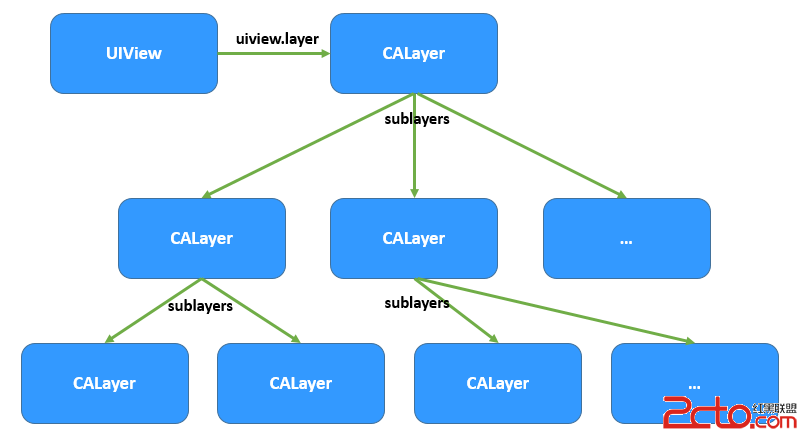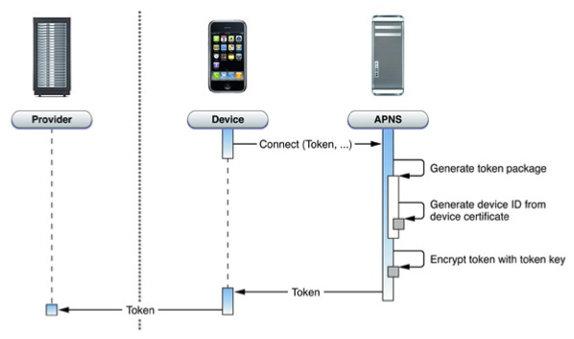[iOS]零碎UITabBarController步驟及自定義
關於UITabBarController, 大家都不生疏, 但是有時分又不那麼的熟習, 上面就來再看法一下這個熟習的生疏人.
以下運用微信的tabBar圖標;
一. 零碎UITabBarController根本運用 1.1 根本用法UITabBarController的運用, 其實很復雜, 這裡直接給出相應代碼:
- (BOOL)application:(UIApplication *)application didFinishLaunchingWithOptions:(NSDictionary *)launchOptions {
// Override point for customization after application launch.
// 初始化UITabBarController實例對象
UITabBarController *tabBar = [[UITabBarController alloc]init];
// 創立子控制器
UIViewController *vc1 = [[UIViewController alloc]init];
vc1.view.backgroundColor = [UIColor redColor];
// 設置標題
vc1.tabBarItem.title = @"微信";
// 設置選中形態的圖片
vc1.tabBarItem.selectedImage = [UIImage imageNamed:@"tabbar_mainframeHL"];
// 設置未選中形態的圖片
vc1.tabBarItem.image = [UIImage imageNamed:@"tabbar_mainframe"] ;
// 設置右上角顯示數字(例如: 未讀音訊數目)
vc1.tabBarItem.badgeValue = @"100";
// 右上角數字背風光
vc1.tabBarItem.badgeColor = [UIColor greenColor];
UIViewController *vc2 = [[UIViewController alloc]init];
vc2.view.backgroundColor = [UIColor orangeColor];
vc2.tabBarItem.title = @"聯絡人";
vc2.tabBarItem.selectedImage = [UIImage imageNamed:@"tabbar_contactsHL"];
vc2.tabBarItem.image = [UIImage imageNamed:@"tabbar_contacts"];
UIViewController *vc3 = [[UIViewController alloc]init];
vc3.view.backgroundColor = [UIColor cyanColor];
vc3.tabBarItem.title = @"發現";
vc3.tabBarItem.image = [UIImage imageNamed:@"tabbar_discover"];
vc3.tabBarItem.selectedImage = [UIImage imageNamed:@"tabbar_discoverHL"];
UIViewController *vc4 = [[UIViewController alloc]init];
vc4.view.backgroundColor = [UIColor whiteColor];
vc4.tabBarItem.title = @"我";
vc4.tabBarItem.image = [UIImage imageNamed:@"tabbar_me"];
vc4.tabBarItem.selectedImage = [UIImage imageNamed:@"tabbar_meHL"];
// 添加子視圖到tabbar
tabBar.viewControllers = @[vc1, vc2, vc3, vc4];
// 設置為Window跟視圖
self.Window.rootViewController = tabBar;
return YES;
}以上代碼直接寫在xxAppDelegate.m的下面這個辦法裡即可;
效果如下:
![[IOS]系統UITabBarController步驟及自定義](http://www.php8.org/d/file/p/20161218/php8t0v5pfphsvf.png)
留意:這裡運用的是微信的圖標, 是綠色的, 設置完後變成了藍色, 而且下面也沒有設置選中及未選中文字的顏色, 這裡都被默許設置了, 最次要的是沒有顯示我原先圖標的顏色.( 這樣美工是不贊同的 ��).
1.2. 顯示原圖依據下面的問題, 我們先來看看圖標的問題, 為了不被零碎渲染成藍色, 這裡我們在設置各個控制器的選中和未選中的圖標的時分, 調用一下UIImage的這個辦法即可imageWithRenderingMode:
// 設置選中形態的圖片
vc1.tabBarItem.selectedImage = [[UIImage imageNamed:@"tabbar_mainframeHL"] imageWithRenderingMode:UIImageRenderingModeAlwaysOriginal];
// 設置未選中形態的圖片
vc1.tabBarItem.image = [[UIImage imageNamed:@"tabbar_mainframe"] imageWithRenderingMode:UIImageRenderingModeAlwaysOriginal];![[IOS]系統UITabBarController步驟及自定義](http://www.php8.org/d/file/p/20161218/php8uhdqyzv0y3t.png)
這樣就能正確顯示我們原先的圖片了;
但是文字的顏色並不是我們需求的, 我們可以經過上面的辦法, 來修正文字的顏色:
// 未選中形態下文字顏色
[vc1.tabBarItem setTitleTextAttributes:@{NSForegroundColorAttributeName: [UIColor redColor]} forState:UIControlStateNormal];
// 選中形態下的文字顏色
[vc1.tabBarItem setTitleTextAttributes:@{NSForegroundColorAttributeName: [UIColor blueColor]} forState:UIControlStateSelected];這是設置選中和未選中形態下的標題屬性, 效果如下:
![[IOS]系統UITabBarController步驟及自定義](http://www.php8.org/d/file/p/20161218/php82xxm0yqflxp.png)
這裡我只是修正了前兩個控制器的文字, 前面的還是用的默許的.
下面是修正按鈕標題的文字屬性, 按鈕右上角的角標的文字屬性, 可運用上面的辦法來修正:
// 未選中形態下的角標文字顏色
[vc1.tabBarItem setBadgeTextAttributes:@{NSForegroundColorAttributeName: [UIColor blackColor]} forState:UIControlStateNormal];
// 選中形態下的角標文字顏色
[vc1.tabBarItem setBadgeTextAttributes:@{NSForegroundColorAttributeName: [UIColor orangeColor]} forState:UIControlStateSelected];![[iOS]系統UITabBarController步驟及自定義](https://www.ios5.online/ios/UploadFiles_8070/201703/2017031615413620.png)
![[iOS]系統UITabBarController步驟及自定義](https://www.ios5.online/ios/UploadFiles_8070/201703/2017031615413608.png)
以上就是零碎自帶UITabBarController及相關屬性的設置, 關於圖標規則的需求根本都能滿足, 假如還有其他的需求, 零碎不能滿足的, 就只能自定義了.
二. 自定義tabBarController關於自定義的tabBar, 我們普通還是定義為UITabBarController的子類:
@interface LZTabBarController : UITabBarController這樣我們可以借助UITabBarController的一些屬性和辦法, 例如切換控制器; 不必再去寫切換的邏輯;
實踐上, 我們說的自定義的tabBar, 對數狀況下是自定義的底部的tabBar; 所以, 我們的重點是來設置底部視圖的完成.
我們自定義的時分, 普通有兩種選擇:
- 一種是, 隱藏掉零碎的tabBar, 完全重新規劃;
- 另一種是, 運用零碎的tabBar, 但是自定義tabBarItem
不論是哪一種, 都需求自定義一個tabBarItem, 所以, 先來看看怎樣定義這個tabBarItem;
2.1 自定義item –LZTabBarItem這個類, 次要做的是規劃item, 及呼應點擊事情
我們定義一個類* LZTabBarItem*, 承繼自UIView, .h聲明文件如下:
//
// LZTabBarItem.h
// LZTabBarController
//
// Created by Artron_LQQ on 2016/12/12.
// Copyright © 2016年 Artup. All rights reserved.
//
@protocol LZTabBarItemDelegate;
@interface LZTabBarItem : UIView
@property (nonatomic, copy) NSString *icon;
@property (nonatomic, copy) NSString *title;
@property (nonatomic, strong) UIColor *titleColor;
@property (nonatomic, assign) id <LZTabBarItemDelegate> delegate;
@end
@protocol LZTabBarItemDelegate <NSObject>
- (void)tabBarItem:(LZTabBarItem *)item didSelectIndex:(NSInteger)index;
@end這裡運用代理來回調點擊事情; .m完成如下:
//
// LZTabBarItem.m
// LZTabBarController
//
// Created by Artron_LQQ on 2016/12/12.
// Copyright © 2016年 Artup. All rights reserved.
//
#import "LZTabBarItem.h"
static NSInteger defaultTag = 100000;
@interface LZTabBarItem ()
@property (nonatomic, strong)UIImageView *iconImageView;
@property (nonatomic, strong)UILabel *titleLabel;
@end
@implementation LZTabBarItem
- (instancetype)init {
self = [super init];
if (self) {
self.userInteractionEnabled = YES;
UITapGestureRecognizer *tap = [[UITapGestureRecognizer alloc]initWithtarget:self action:@selector(itemClicked:)];
[self addGestureRecognizer:tap];
}
return self;
}
// 重寫setTag辦法
- (void)setTag:(NSInteger)tag {
[super setTag:tag + defaultTag];
}
- (UIImageView *)iconImageView {
if (_iconImageView == nil) {
_iconImageView = [[UIImageView alloc]init];
_iconImageView.contentMode = UIViewContentModeScaleaspectFit;
[self addSubview:_iconImageView];
}
return _iconImageView;
}
- (UILabel *)titleLabel {
if (_titleLabel == nil) {
_titleLabel = [[UILabel alloc]init];
_titleLabel.textAlignment = NSTextAlignmentCenter;
_titleLabel.font = [UIFont systemFontOfSize:10];
_titleLabel.numberOfLines = 0;
_titleLabel.textColor = [UIColor grayColor];
[self addSubview:_titleLabel];
}
return _titleLabel;
}
- (void)setIcon:(NSString *)icon {
_icon = icon;
self.iconImageView.image = [UIImage imageNamed:icon];
}
- (void)setTitle:(NSString *)title {
_title = title;
self.titleLabel.text = title;
}
- (void)setTitleColor:(UIColor *)titleColor {
_titleColor = titleColor;
self.titleLabel.textColor = titleColor;
}
- (void)layoutSubviews {
[super layoutSubviews];
CGFloat space = 6.0;
if (self.icon.length > 0 && self.title.length > 0) {
CGFloat iconHeight = (CGRectGetHeight(self.frame) - space * 3)*2/3.0 ;
self.iconImageView.frame = CGRectMake(space, space, CGRectGetWidth(self.frame) - 2 * space, iconHeight);
self.titleLabel.frame = CGRectMake(space, CGRectGetMaxY(self.iconImageView.frame) + space, CGRectGetWidth(self.frame) - 2*space, iconHeight/2.0);
} else if (self.icon.length > 0) {
self.iconImageView.frame = CGRectMake(2, 2, CGRectGetWidth(self.frame) - 4, CGRectGetHeight(self.frame) - 4);
} else if (self.title.length > 0) {
self.titleLabel.frame = CGRectMake(2, CGRectGetHeight(self.frame) - 22, CGRectGetWidth(self.frame) - 4, 20);
}
}
- (void)itemClicked:(UITapGestureRecognizer *)tap {
if (self.delegate && [self.delegate respondsToSelector:@selector(tabBarItem:didSelectIndex:)]) {
[self.delegate tabBarItem:self didSelectIndex:self.tag - defaultTag];
}
}
/*
// Only override drawRect: if you perform custom draWing.
// An empty implementation adversely affects performance during animation.
- (void)drawRect:(CGRect)rect {
// Drawing code
}
*/
@end其實, 很復雜, 只是添加了一個imageView, 一個label, 和一個單擊手勢來呼應點擊事情. 這裡我是在* layoutSubviews*辦法裡來規劃子視圖的, 這樣當視圖frame改動的時分, 其子視圖會做相應的調整;
這樣,tabBarItem的自定義就完成了,接上去就是自定義tabBar;
tabBar的定義, 有兩種辦法:
- 一個是承繼自UIView, 完全自定義;
- 一個是承繼自UITabBar;
先來看一下承繼自UIView, 完全自定義的辦法:
//
// LZTabBar.h
// LZTabBarController
//
// Created by Artron_LQQ on 2016/12/12.
// Copyright © 2016年 Artup. All rights reserved.
//
#import <UIKit/UIKit.h>
@class LZTabBarItem;
@protocol LZTabBarDelegate;
@interface LZTabBar : UIView
@property (nonatomic, strong)NSArray<LZTabBarItem *> *items;
@property (nonatomic, assign)id <LZTabBarDelegate> delegate;
@end
@protocol LZTabBarDelegate <NSObject>
- (void)tabBar:(LZTabBar *)tab didSelectItem:(LZTabBarItem *)item atIndex:(NSInteger)index ;
@end這裡是.h文件內容, 其屬性比擬復雜, 只設置了delegate和items;
.m的完成如下:
//
// LZTabBar.m
// LZTabBarController
//
// Created by Artron_LQQ on 2016/12/12.
// Copyright © 2016年 Artup. All rights reserved.
//
#import "LZTabBar.h"
#import "LZTabBarItem.h"
@interface LZTabBar ()<LZTabBarItemDelegate>
@property (nonatomic, strong) UIVisualEffectView *effectView;
@property (nonatomic, strong) UIView *topLine;
@end
@implementation LZTabBar
- (instancetype)init {
self = [super init];
if (self) {
self.backgroundColor = [UIColor whiteColor];
}
return self;
}
- (UIView *)topLine {
if (_topLine == nil) {
_topLine = [[UIView alloc]init];
_topLine.backgroundColor = [UIColor grayColor];
[self addSubview:_topLine];
}
return _topLine;
}
- (UIVisualEffectView *)effectView {
if (_effectView == nil) {
UIBlurEffect *effect = [UIBlurEffect effectWithStyle:UIBlurEffectStyleLight];
_effectView = [[UIVisualEffectView alloc] initWithEffect:effect];
_effectView.alpha = 1.0;
[self addSubview:_effectView];
}
return _effectView;
}
- (void)layoutSubviews {
[super layoutSubviews];
self.effectView.frame = self.bounds;
[self setupItems];
self.topLine.frame = CGRectMake(0, 0, CGRectGetWidth(self.frame), 0.6);
}
- (void)setupItems {
CGFloat width = CGRectGetWidth(self.frame)/self.items.count;
CGFloat height = CGRectGetHeight(self.frame);
for (int i = 0; i < self.items.count; i++) {
LZTabBarItem *item = [self.items objectAtIndex:i];
item.frame = CGRectMake(i*width, 0, width, height);
[self addSubview:item];
item.delegate = self;
}
}
- (void)tabBarItem:(LZTabBarItem *)item didSelectIndex:(NSInteger)index {
if (self.delegate && [self.delegate respondsToSelector:@selector(tabBar:didSelectItem:atIndex:)]) {
[self.delegate tabBar:self didSelectItem:item atIndex:index];
}
}
/*
// Only override drawRect: if you perform custom drawing.
// An empty implementation adversely affects performance during animation.
- (void)drawRect:(CGRect)rect {
// Drawing code
}
*/
@end這個類的次要作用是: 規劃各個item, 在tabBar的地位, 及tabBar的一些內容.
接上去, 就是定義LZTabBarController了;
2.3 自定義LZTabBarController這個類的次要作用是: 提供數據源, 繪制底部tabBar, 及關聯viewController;
在提供數據的時分, 我獨自設置了一個類類貯存這些數據, 而沒有直接設置為* LZTabBarController*的屬性:
#pragma mark - LZTabBarConfig
@interface LZTabBarConfig : NSObject
/**
控制器數組, 必需設置
*/
@property (nonatomic, strong) NSArray *viewControllers;
/**
item標題數組, 選擇設置
*/
@property (nonatomic, strong) NSArray *titles;
/**
能否是導航, 默許 YES
*/
@property (nonatomic, assign) BOOL isNavigation;
/**
選中形態下的圖片數組
*/
@property (nonatomic, strong) NSArray *selectedImages;
/**
正常形態下的圖片數組
*/
@property (nonatomic, strong) NSArray *normalImages;
/**
選中形態下的標題顏色 默許: red
*/
@property (nonatomic, strong) UIColor *selectedColor;
/**
正常形態下的標題顏色 默許: gray
*/
@property (nonatomic, strong) UIColor *normalColor;
@end提供數據源的時分, 只需求配置這個config即可;
其.m文件, 只是設置了一些默許值:
@implementation LZTabBarConfig
- (instancetype)init {
self = [super init];
if (self) {
_isNavigation = YES;
_normalColor = [UIColor grayColor];
_selectedColor = [UIColor redColor];
}
return self;
}
@end上面, 回到* LZTabBarController*, 其.h的聲明, 就簡約許多:
#import <UIKit/UIKit.h>
@class LZTabBarConfig;
typedef LZTabBarConfig*(^tabBarBlock)(LZTabBarConfig *config);
@interface LZTabBarController : UITabBarController
/**
能否可用自動旋轉屏幕
*/
@property (nonatomic, assign) BOOL isAutoRotation;
/**
創立tabBarController
@param block 配置創立tabBarController所需的參數
@return 前往tabBarController實例對象
*/
+ (instancetype)createTabBarController:(tabBarBlock)block;
/**
獲取以後的tabBarController實例, 實例創立後可經過此辦法獲取以後實例
@return 前往tabBarController實例對象
*/
+ (instancetype)defaultTabBarController;
/**
隱藏底部tabBar的辦法
@param isAnimation 能否需求動畫
*/
- (void)hiddenTabBarWithAnimation:(BOOL)isAnimation;
/**
顯示底部tabBar的辦法
@param isAnimation 能否需求動畫
*/
- (void)showTabBarWithAnimation:(BOOL)isAnimation;
@end只是提供了創立的辦法, 及獲取以後實例和隱藏/顯示底部tabBar的辦法;
.m中的完成:
//
// LZTabBarController.m
// LZTabBarController
//
// Created by Artron_LQQ on 2016/12/12.
// Copyright © 2016年 Artup. All rights reserved.
//
#import "LZTabBarController.h"
#import "LZTabBar.h"
static CGFloat lzTabBarHeight = 49.0;
@interface LZTabBarController ()<LZTabBarDelegate>
@property (nonatomic, strong) LZTabBar *customTabBar;
@property (nonatomic, strong) LZTabBarConfig *config;
@end
@implementation LZTabBarController
- (LZTabBar *)customTabBar {
if (_customTabBar == nil) {
_customTabBar = [[LZTabBar alloc]init];
_customTabBar.delegate = self;
}
return _customTabBar;
}
+ (instancetype)createTabBarController:(tabBarBlock)block {
static dispatch_once_t onceToken;
static LZTabBarController *tabBar;
dispatch_once(&onceToken, ^{
tabBar = [[LZTabBarController alloc]initWithBlock:block];
});
return tabBar;
}
+ (instancetype)defaultTabBarController {
return [LZTabBarController createTabBarController:nil];
}
- (void)hiddenTabBarWithAnimation:(BOOL)isAnimation {
if (isAnimation) {
[UIView animateWithDuration:0.2 animations:^{
self.customTabBar.alpha = 0;
}];
} else {
self.customTabBar.alpha = 0;
}
}
- (void)showTabBarWithAnimation:(BOOL)isAnimation {
if (isAnimation) {
[UIView animateWithDuration:0.2 animations:^{
self.customTabBar.alpha = 1.0;
}];
} else {
self.customTabBar.alpha = 1.0;
}
}
- (instancetype)initWithBlock:(tabBarBlock)block {
self = [super init];
if (self) {
LZTabBarConfig *config = [[LZTabBarConfig alloc]init];
NSAssert(block, @"Param in zhe function, can not be nil");
if (block) {
_config = block(config);
}
NSAssert(_config.viewControllers, @"Param 'viewControllers' in the 'config', can not be nil");
[self setupViewControllers];
[self setupTabBar];
_isAutoRotation = YES;
}
return self;
}
- (void)setupViewControllers {
if (_config.isNavigation) {
NSMutableArray *vcs = [NSMutableArray arrayWithCapacity:_config.viewControllers.count];
for (UIViewController *vc in _config.viewControllers) {
if (![vc isKindOfClass:[UINavigationController class]]) {
UINavigationController *nav = [[UINavigationController alloc]initWithRootViewController:vc];
[vcs addObject:nav];
} else {
[vcs addObject:vc];
}
}
self.viewControllers = [vcs copy];
} else {
self.viewControllers = [_config.viewControllers copy];
}
}
- (void)setupTabBar {
NSMutableArray *items = [NSMutableArray array];
for (int i = 0; i < _config.viewControllers.count; i++) {
LZTabBarItem *item = [[LZTabBarItem alloc]init];
if (i == 0) {
item.icon = _config.selectedImages[i];
if (_config.titles.count > 0) {
item.titleColor = _config.selectedColor;
}
} else {
item.icon = _config.normalImages[i];
if (_config.titles.count > 0) {
item.titleColor = _config.normalColor;
}
}
if (i < _config.titles.count) {
item.title = _config.titles[i];
}
[items addObject:item];
item.tag = i;
}
// 隱藏掉零碎的tabBar
self.tabBar.hidden = YES;
self.customTabBar.items = [items copy];
self.customTabBar.frame = CGRectMake(0, CGRectGetHeight(self.view.frame) - lzTabBarHeight, CGRectGetWidth(self.view.frame), lzTabBarHeight);
[self.view addSubview:self.customTabBar];
}
- (void)viewDidLoad {
[super viewDidLoad];
// Do any additional setup after loading the view.
self.view.backgroundColor = [UIColor whiteColor];
self.selectedIndex = 0;
}
#pragma mark - LZTabBarDelegate
- (void)tabBar:(LZTabBar *)tab didSelectItem:(LZTabBarItem *)item atIndex:(NSInteger)index {
NSMutableArray *items = [NSMutableArray arrayWithCapacity:0];
for (UIView *view in tab.subviews) {
if ([view isKindOfClass:[LZTabBarItem class]]) {
[items addObject:view];
}
}
for (int i = 0; i < items.count; i++) {
UIView *view = items[i];
if ([view isKindOfClass:[LZTabBarItem class]]) {
LZTabBarItem *item = (LZTabBarItem *)view;
item.icon = self.config.normalImages[i];
if (self.config.titles.count > 0) {
item.titleColor = _config.normalColor;
}
}
}
item.icon = self.config.selectedImages[index];
if (self.config.titles.count > 0) {
item.titleColor = self.config.selectedColor;
}
self.selectedIndex = index;
}
// 屏幕旋轉時調整tabbar
- (void)viewWillTransitionToSize:(CGSize)size withTransitionCoordinator:(id<UIViewControllerTransitionCoordinator>)coordinator {
[super viewWillTransitionToSize:size withTransitionCoordinator:coordinator];
self.customTabBar.frame = CGRectMake(0, size.height - lzTabBarHeight, size.width, lzTabBarHeight);
}
- (BOOL)shouldAutorotate {
return self.isAutoRotation;
}
- (UIInterfaceOrientationMask)supportedInterfaceOrientations {
if (self.isAutoRotation) {
return UIInterfaceOrientationMaskAllButUpsideDown;
} else {
return UIInterfaceOrientationMaskPortrait;
}
}
- (void)didReceiveMemoryWarning {
[super didReceiveMemoryWarning];
// Dispose of any resources that can be recreated.
}
/*
#pragma mark - Navigation
// In a storyboard-based application, you will often want to do a little preparation before navigation
- (void)prepareForSegue:(UIStoryboardSegue *)segue sender:(id)sender {
// Get the new view controller using [segue destinationViewController].
// Pass the selected object to the new view controller.
}
*/
@end這裡次要的其實就是, * setupTabBar*辦法
和* LZTabBarDelegate*的代理辦法tabBar:(LZTabBar )tab didSelectItem:(LZTabBarItem )item atIndex:(NSInteger)index, 需求處置一些形態的轉換;
到此, 第一種的自定義就完畢了, 效果如下:
![[iOS]系統UITabBarController步驟及自定義](https://www.ios5.online/ios/UploadFiles_8070/201703/2017031615413603.gif)
需求留意的是:
由於我們自定義了tabBar , 所以控制器的屬性hidesBottomBarWhenPushed 就得到效果了, 處理的辦法可以是在適宜的中央來調用隱藏/顯示的辦法;
假如, 還想運用零碎的* hidesBottomBarWhenPushed*效果, 可在運用的時分, 調整一下辦法:普通, 我們是直接將tabBarController作為window的rootvc, 然後在其子控制器辨別加上導航, 我們可以做如下調整:
將tabBar作為UINavigationController的rootvc, 然後把這個導航作為window的rootvc:
// 為了可以運用hidesBottomBarWhenPushed, 不直接把tabBar設置為window的跟視圖, 而是設置為導航的rootvc, 然後把導航設置為window的跟視圖
// 這樣, 在子控制器上就不必再添加導航了, 即設置: config.isNavigation = NO;
UINavigationController *nav = [[UINavigationController alloc]initWithRootViewController:tab];
// 翻開hidesBottomBarWhenPushed
nav.hidesBottomBarWhenPushed = YES;
self.window.rootViewController = nav;這樣做, 需求留意的是, 其子控制器就不必再添加導航了.
這樣, 就會有下面Gif的效果;
demo地址: LZTabBarController
承繼自UITabBar的方式, 與承繼自UIView, 次要的區別是LZTabBar的內容, 其他如LZTabBarItem 和LZTabBarController相關邏輯都是一樣的;
#import <UIKit/UIKit.h>
@class LZTabBarItem;
@protocol LZTabBarDelegate;
@interface LZTabBar : UITabBar
@property (nonatomic, strong)NSArray<LZTabBarItem *> *lzItems;
@property (nonatomic, assign)id <LZTabBarDelegate> lzDelegate;
@end
@protocol LZTabBarDelegate <NSObject>
- (void)tabBar:(LZTabBar *)tab didSelectItem:(LZTabBarItem *)item atIndex:(NSInteger)index ;
@end.m的完成中, 次要是將零碎的item移除掉, 然後添加上自定義的item:
#import "LZTabBar.h"
@interface LZTabBar ()<LZTabBarItemDelegate>
@end
@implementation LZTabBar
- (instancetype)init {
self = [super init];
if (self) {
self.backgroundColor = [UIColor whiteColor];
}
return self;
}
- (void)layoutSubviews {
[super layoutSubviews];
// 移除零碎的tabBarItem
Class class = NSClassFromString(@"UITabBarButton");
for (UIView *item in self.subviews) {
if ([item isKindOfClass:class]) {
[item removeFromSuperview];
}
}
// 設置自定義的tabBarItem
[self setupItems];
}
- (void)setupItems {
CGFloat width = CGRectGetWidth(self.frame)/self.items.count;
CGFloat height = CGRectGetHeight(self.frame);
for (int i = 0; i < self.lzItems.count; i++) {
LZTabBarItem *item = [self.lzItems objectAtIndex:i];
item.frame = CGRectMake(i*width, 0, width, height);
[self addSubview:item];
item.delegate = self;
}
}
- (void)tabBarItem:(LZTabBarItem *)item didSelectIndex:(NSInteger)index {
if (self.lzDelegate && [self.lzDelegate respondsToSelector:@selector(tabBar:didSelectItem:atIndex:)]) {
[self.lzDelegate tabBar:self didSelectItem:item atIndex:index];
}
}
/*
// Only override drawRect: if you perform custom drawing.
// An empty implementation adversely affects performance during animation.
- (void)drawRect:(CGRect)rect {
// Drawing code
}
*/
@end
其最終的效果是一樣的, 只不過我們可以在執行push操作的時分運用控制器的* hidesBottomBarWhenPushed*屬性來隱藏底部的tabBar;
(完)【[iOS]零碎UITabBarController步驟及自定義】的相關資料介紹到這裡,希望對您有所幫助! 提示:不會對讀者因本文所帶來的任何損失負責。如果您支持就請把本站添加至收藏夾哦!
- 上一頁:IOS界面開發之UILabel
- 下一頁:計算字符串的寬度與高度




